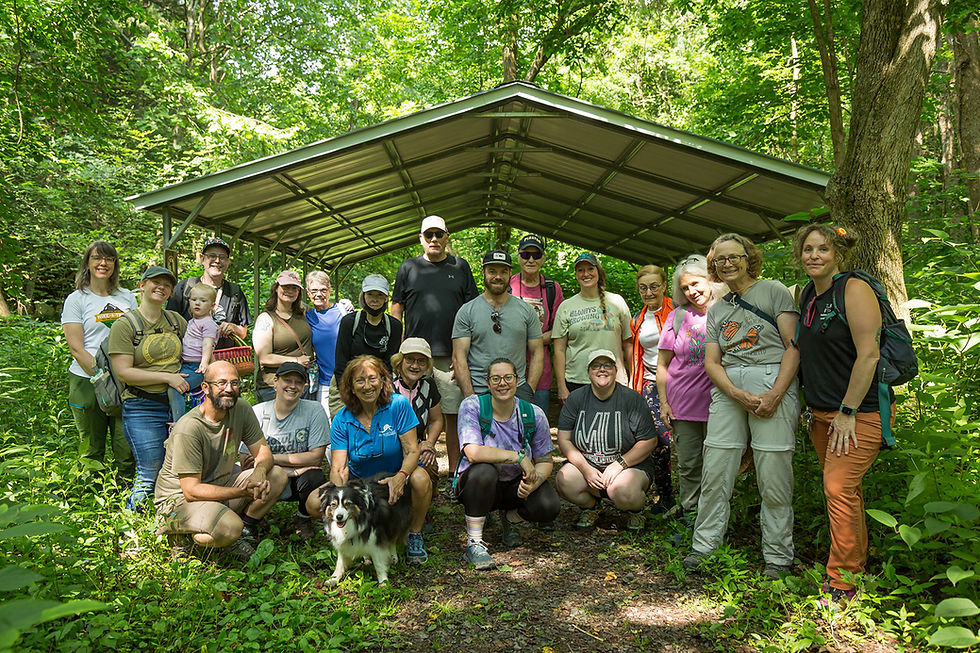Foraging Fun Abounds in Western PA
- Kathleen Ganster
- Jul 31
- 4 min read

“Finding a mushroom in the wild is a treasure hunt. If you’re lucky, you find free food,” said Cecily Franklin, a member of the Western Pennsylvania Mushroom Club (WPMC).

And who doesn’t like a treasure hunt? Foraging—including searching for mushrooms—is indeed a type of treasure hunting. Foraging is, quite simply, the act of searching for and gathering food in natural settings. Nuts, mushrooms, berries, greens, and seeds are some of the most common foods found while foraging in Western PA.
WPMC is a nonprofit that was established in 2000 to create a community of people who share a passion for fungi. According to Franklin, they are one of the largest mycological clubs in North America, with nearly 800 members.

There are many reasons people enjoy foraging, Franklin said. “You might find species that aren’t available in the store. You can find much fresher specimens in the wild,” she explained. “It’s a treasure hunt, regardless of whether you’re looking for edible mushrooms or just trying to identify them, and it’s a great way to socialize. Being outdoors, in the woods, and in fresh air is good for you.”
For Adam Haritan, foraging means finding fresh, nutritious foods. “I studied nutrition in college and became really interested in healthy eating. I realized that a lot of plants I could find outside were really nutritious—more nutritious than ones I could buy in the store—so I started foraging,” he said.
It also helped that he loved being outside—so much so that he quit his job working as a nutrition educator to spend more time outdoors. As he did more research and gained more knowledge, Haritan started his own company in 2015, aptly named Learn Your Land, to teach others about the natural world, including foraging.
“I received a good scientific foundation through Pitt and continued to research to learn more. I attended conferences, studied independently, and spent a lot of time outdoors to teach myself,” he said. “And I wanted to share that knowledge with others.”

Haritan has become a foraging expert and said that Western PA has a wealth of natural food available. “We are blessed with a very productive landscape,” he noted.
It’s easy to start foraging, according to both Haritan and Franklin. “Start where you are comfortable and look around you. Wild foods often resemble what you’re familiar with buying in the store—wild strawberries look like regular strawberries. So do blueberries. Raspberries look identical. And everyone has dandelion greens in their yard,” Haritan said.
He also pointed to the abundance of nuts in the region. “There are a lot of nut-producing trees—hickory, walnuts, acorns, butternuts. Late summer and fall are great for nut foraging,” he added.
There are many resources available, including walks and hikes sponsored by the Audubon Society, Allegheny Land Trust, and groups such as WPMC. “We have monthly meetings, frequent guided mushroom walks, an ID button program, an annual photo contest, Mushroom Education Day, and the Gary Lincoff Foray,” Franklin said.
The Gary Lincoff Foray is an all-day program open to all members that features speakers and presentations, walks, display tables, and culminates with a mushroom feast. Franklin explained that Lincoff was a Pittsburgh native who wrote the first National Audubon Society Field Guide to North American Mushrooms.
It is important to know what you are putting into your mouth, both Franklin and Haritan emphasized. “Everyone knows that mushrooms can either be edible or ‘dead-able.’ People get started with foraging when they find mushrooms and want to know what they are. The best thing to do is to take photos and find knowledgeable experts who can help identify them,” Franklin advised.
Franklin became interested in foraging when she began to explore her own property. As she and her husband cleared some of their land, they discovered something bright orange. “At first we thought it was trash. My husband thought it was a traffic cone,” she said. It turned out to be a mushroom, and they began finding and identifying other types as well. Today, Franklin enjoys cooking with many of the mushrooms she finds.
Haritan offers various online classes, plus in-person presentations and programs—including a recent Summer Forest Ecology event at McConnell’s Mill State Park that included mushroom ecology and identification.
Becoming familiar with the outdoors and wild landscapes is important. “Hang out with people who enjoy the outdoors and know it. There are a lot of nature clubs around here,” Haritan said.
According to Franklin, WPMC also has an ID Button program, which awards pins for as few as 10 confirmed identifications. To be a club identifier, you need to know at least 150 species, and to be a club mycologist, you need to know at least 500, she explained.
Since foraging means being outdoors, the usual precautions apply: be mindful of poison ivy and oak, protect yourself against ticks, and, of course, only forage where you have permission.
Franklin shared this word of awareness:
“WPMC does not endorse or support the commercial harvesting of wild mushrooms from any state, county, or city park. WPMC does promote the gathering of mushrooms—where permitted—for recreational, educational, and scientific purposes.”
Foraging is something anyone can do, Haritan said. “We come from a line of foragers—our ancestors were hunters and gatherers, and that’s exactly what gatherers are doing: foraging. It’s in your blood,” he said. “Foraging connects you to nature, and really, it’s one of the best ways to do it.”
For more information, visit:



















Comments